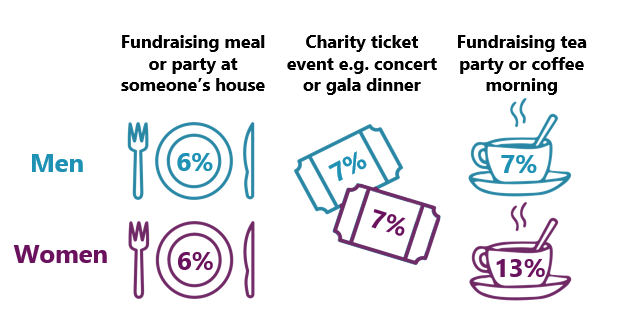In nfpSynergy’s supporter satisfaction benchmark we have consistently seen female supporters taking the majority in the databases of our clients (at 63%). A powerful force of ‘Dorothy/ Danielle/ Denise donors’ supporting and funding the nation's charities. This blog will explore the gender divide in the ways that the general public interact with charities. Gender is not a clear distinction and there are many other gender identities, however, within our data we can see this can be a driver of difference in the way people engage with charities so is important to explore.
I am definitely not saying that all men or all women act the same, but with limited budget and resources, targeting the audiences who are most likely to engage is key to getting cut-through. If men and women are interacting more or less with charities in varied ways then you need to use knowledge of these differences to your advantage.
Women are more likely to be donors than men. More women are the faithful mainstay of many charities and the key to achieving your aims through funding your charities’ activities. Some causes will appeal to, and engage one gender more than another due to their cause such as Girlguiding vs Prostate Cancer UK. However, at the highest level both our supporter and general public research show a greater level of charitable and financial support from women, with 71% of women stating that they have donated to charity in the last 3 months compared to 60% of men[1].
Fundraising events has a higher level of consistency between both men and women for both doing fundraising activities and sponsoring someone else to do something. As can be seen below there is very little difference between men and women in their attendance or involvement in fundraising events and the same can be seen for sporting/adventure events. The only activity where we can see any difference in engagement is for fundraising tea parties or coffee mornings which will probably come as no surprise!

‘In the last 12 months, have you attended any of the following charity events?’
nfpSynergy’s Charity Awareness Monitor | 1,000 adults, Britain, February 2019
Legacies; this is an area where the tables are turned and men over-perform in their support. The level of consideration for legacy giving is equal between men and women, yet those who have left a gift in their will is higher for men. With 27% of men stating that they have already included a charity in their will compared to 18% of women. This is obviously a self-reported figure (see our recent report on the issues around this) and has a much higher correlation with age rather than gender but is an interesting consideration for those promoting legacies.
“Would leaving a gift to charity in your will be something you might consider?” & “Have you included any charities as beneficiaries in your will?”
nfpSynergy’s Charity Awareness Monitor | 1,000 adults, Britain, April 2018
Women came out ahead again when it comes to volunteering. As charities know, it’s not all about money! Volunteering is a key way that individuals support causes, but also can be a way to engage younger groups, or those with less disposable income, in the work that you do. Almost a quarter (24%) of women say that they have volunteered in the last 3 months compared to only 18% of men[2]. Are women therefore slightly easier recruits for volunteering activity or is there more headroom to get men more engaged and volunteering?
However, men are more involved with campaigning. Once again non-monetary engagement can be a really key way to both engage supporters, but also can be a key driver for reaching your charitable aims. Campaigners are a dynamic power source for a wide variety of charities but active participation in campaigns does not follow the same pattern as support, with a quarter of men (26%) agreeing that they are actively involved in campaigns compared to 19% of women. If you are looking to diversify your supporter database could this be a way to engage men with the core aims of your organisation?
Please indicate to what extent you agree or disagree with the following statements:
"I consider myself an active, regular participant in campaigns to influence social or political change"
nfpSynergy’s Charity Awareness Monitor | 1,000 adults, Britain, April 2018
Do you want to understand why or how your supporters are engaging with you, or is the demographic breakdown of your supporter database merely anecdotal information? Take a look at our Supporter Satisfaction Benchmark where you can learn more about your supporters, and compare against our sector average. Download the briefing back below!
If you are interested in learning more about how different parts of the general public interact with charities, and how this can help you target your propositions and campaigns get in contact with the CAM team at CAM@nfpsynergy.net



